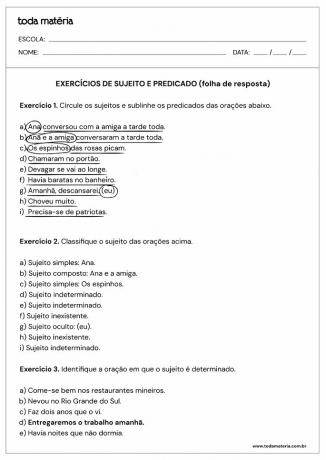Permutations are part of counting problems. We use permutations to know the number of orders of the elements in a set. Practice your knowledge about permutation and resolve your doubts with the solved exercises.
Exercise 1
Two friends were playing with six-sided dice. It is known that numbers 4, 1, 2 and 5 came out, not necessarily in that order. How many sequences of results could there have been?
Answer: 24
Some ordering of results could be:
1, 2, 4 and 5 or
5, 4, 5 and 1 or
4, 5, 1 and 2
To determine the total number of possible orderings, we calculate a permutation with four distinct elements.
Exercise 2
A group of six friends went to watch a movie at the cinema and bought their tickets for the same row of seats. Considering there is a couple and they sat in neighboring chairs, in how many ways could these friends fit in the row of chairs?
Answer: 240
As all elements of the "friends" set are considered in the calculation, it is a permutation problem.
To calculate the total possible number of permutations, we considered 5 elements, as the couple must always be together.
Furthermore, of these 120 possibilities, we must multiply by two, as the couple can exchange places with each other.
Thus, the number of possible ways for friends to organize themselves in the row of chairs is:
120. 2 = 240
Exercise 3
A class of 7 students is playing in the courtyard taking advantage of their break time. Upon hearing the signal that informs the return to the classrooms, the students move to form a line. In how many different ways can students form the queue sequence?
Answer: 5040
The total number of possible ways to organize the queue is a permutation of 7 distinct elements.
Exercise 4
A photographer is adjusting his camera to photograph 5 children arranged on a bench. In this group there are 3 girls and 2 boys. A possible arrangement of the children for the photo would be:
Considering the positions in which children can sit on the bench, in how many ways can the photographer organize the boys and girls, obtaining different photos?
Answer: 10
This is a case of permutation with repeated elements. We must divide the total number of permutations by the product between the permutations of the elements that are repeated.
Exercise 5
How many anagrams can be made with the letters in the word PREFEITURA?
Answer: 907 200
The word CITY HALL has 10 letters, some of which are repeated. The letter E appears twice, as does the R.
We calculate the division between the permutation of 10 elements and divide by the product of the permutations of repeated elements.
Exercise 6
(UEMG 2019) From the set of all permutations of the letters in the word PONTA, one is removed at random. What is the probability of removing a word that begins and ends with a vowel?
a) 1/20
b) 1/10
c) 1/6
d) 1/5
Step 1: number of all permutations with the letters of the word PONTA.
As there are five distinct letters, we have:
Step 2: number of permutations that begin and end with a vowel.
For the first letter there are two vowel options, for the last letter there will only be 1.
For consonants there are 3! possibilities.
2.3!.1 = 2.3.2.1.1 = 12
Step 3: determine the probability ratio.
Exercise 7
(EsPCex 2012) The probability of obtaining a number divisible by 2 when choosing at random one of the permutations of the digits 1, 2, 3, 4, 5 is
a) 1/5
b) 2/5
c) 3/4
d) 1/4
e) 1/2
Step 1: total permutations.
As there are five distinct elements, we have that the number of permutations of 5 elements is equal to 5 factorial.
Step 2: permutations of numbers divisible by two with the five digits.
To be divisible by 2 the condition is that it is even. Thus, there are two options for the last digit, 2 and 4.
For the other positions there are 4! possibilities.
Step 3: probability calculation.
Exercise 8
(EsFCEx 2022) Let P be the set of permutations of the sequence 1, 3, 6, 9, 12 for which the first term is different from 1. If one of these sequences is randomly drawn, the probability that the second term is 3 is equal to p/q, with p, q ∈ IN* and gcd (p, q) = 1. Therefore, q – p is equal to
a) 13.
b) 15.
c) 12.
d) 14.
e) 11.
Step 1: determine the number of total possible cases in the sample space.
From right to left, the first number cannot be one, so there are 4 possibilities to occupy the first position.
There are 4 to occupy the other positions! possibilities.
The permutations are:
1.4! = 4.4.3.2.1 = 96
Step 2: determine the possibilities of the event occurring, the second being three, the first being different from one.
The permutations are:
3.1.3.2.1 = 18
Step 3: probability ratio.
The probability ratio is:
With p = 18 and q = 96.
However, there is still the condition that the greatest common divisor between p and q is 1, which does not occur with 18 and 96.
We must simplify and test fractions equivalent to 18/96.
Step 4: simplification of the probability fraction and determination of p and q.
As gcd (3, 16) = 1, p = 3 and q = 16.
Step 5: conclusion.
q - p = 16 - 3 = 13
Learn more about permutation.
For more exercises, see:
Combinatorial analysis exercises
ASTH, Rafael. Permutation exercises solved and explained.All Matter, [n.d.]. Available in: https://www.todamateria.com.br/exercicios-de-permutacao/. Access at:
See too
- Combinatorial Analysis
- Combinatorial Analysis Exercises
- Permutation: simple and with repetition
- Arrangement in mathematics: what it is, how to calculate, examples
- 27 Basic Mathematics exercises
- Combination in mathematics: how to calculate and examples
- Probability Exercises
- Probability

